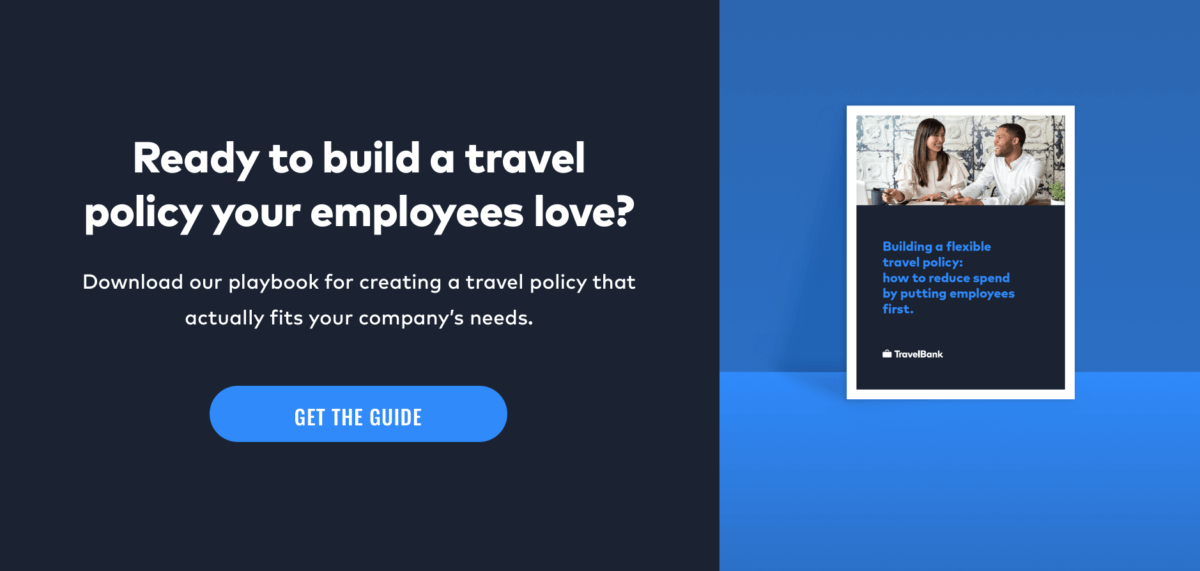7 Reasons Most Travel Managers Haven’t Achieved Travel Policy Compliance
Picture this: you’re reconciling your monthly expenses when you get hit with the bill for your sales team’s last client visit. You recognize the client because it’s a high profile account that your company is working hard to win, but the spend is way over the budget you’ve been agonizing over.
Travel policy compliance isn’t an easy process. Most companies have high travel and entertainment spend, and struggle to get team buy-in for a number of reasons.

If this battle feels all too familiar, it’s likely your policy is in need of a revamp. Here are seven reason why most travel managers haven’t achieved travel policy compliance yet, and most importantly, how to fix the problem head-on.
Your travel policy is outdated.
For the past few decades, travel policy decisions have largely been based on historical data. Companies pull last year’s budget, maybe look at a few flights and hotels in common destination cities, then layer that with past travel information to create a laundry list of price caps and guard rails that are already at least a year out of date. Instead, your finance team needs to be armed with accurate, predictive budgets derived from real-time market data and current industry standards created specifically for business travel. This way, your team can operate with a realistic forecast of spend, and have a clearer way to see what’s coming.
Your travel policy isn’t flexible.
Most travel policies are too hard-line to handle variable travel scenarios. These policies define a rigid set of standards that are so granular, they leave travelers with a long list of “what if”s and special circumstances. This means poor compliance, unhappy travelers, and extra work for the finance and operations teams as they spend more time tracking spend, reviewing one-off requests, and asking for justifications travelers may or may not have. Flexible travel policies shift your focus from deciphering a dozen cryptic rules to a single and powerful goal: beat your budget.
Your travel policy is one-size-fits-all.
As a culture, we’re used to buying an in-the-box solution and calling it a day, but this is one area where it’s worth it to customize. Unfortunately, there’s no universal policy that works for everyone. Maybe you worked at a Fortune 500 company and you had a lot of success with compliance, but that doesn’t mean the same travel policy will work for your new startup. It takes more time to create a bespoke policy, but the customization goes a long way, and there’s tech that can make it easier. Whatever platform you use, it should help you create a unique policy that’s built for your employees’ and your company’s needs.
Your travel policy doesn’t balance everyone’s needs.
On one side, management is concerned with policy compliance so they can reduce spend. On the other, travelers want comfort and access to amenities so they can do their job well on the road. There’s a clear tension between management policing spend and travelers going over budget. It’s important to balance these needs because while increasing cost savings will help your bottom line, employee engagement will, too. Wondering how to strike the perfect balance? Download our travel policy guide to help employees and travel managers meet in the middle.
Your travel policy makes employees unhappy.
It may not be a travel manager’s intention to upset their staff, but when you make calls based purely on the bottom line and don’t consider your top performer’s needs, you can create setbacks for company culture. The chief HR officer at IBM found that, “employee engagement explains two-thirds of our client experience scores. If we increase client satisfaction by five points on an account, we see an extra 20% in revenue, on average.” In short, employee engagement correlates with revenue, and happy employees will generate more revenue for business.
Your travel policy is based on negative reinforcement.
Too often, travel policies outline the way employees have to handle travel spend, and only reimburse them after the fact. If employees make a mistake tracking expenses or overspend, their reimbursement is at stake. Instead, you can improve your relationship with your employees and your overall culture by rewarding them each time they make a good financial decision, like flying at a different time so they can book a less expensive flight. Learn more about the benefits of incentivizing positive behavior in our downloadable travel policy guide.
Your travel policy isn’t built in.
Is your travel policy native to your travel management system or booking tool, or do employees have to figure it out on their own? If you aren’t paying your employees to execute the travel policy, why ask them to waste their time? Instead, pick technology with a travel policy that’s already baked in. With a native policy, your staff can save time and nail compliance directly within your travel management tool.


